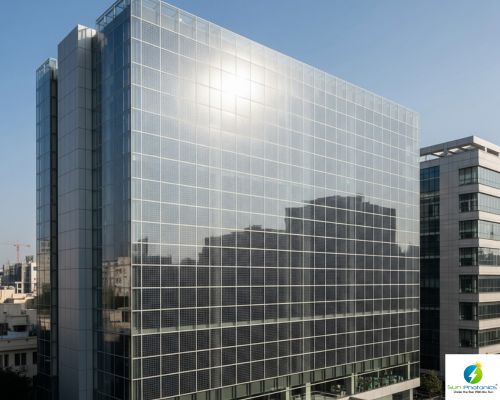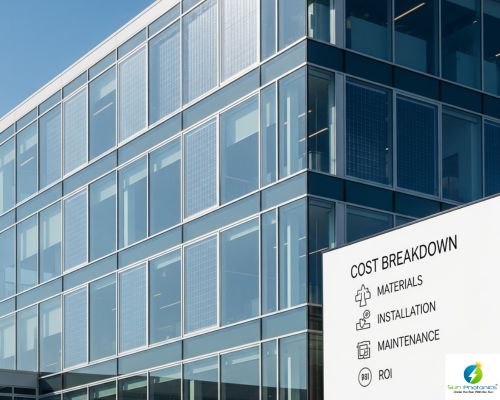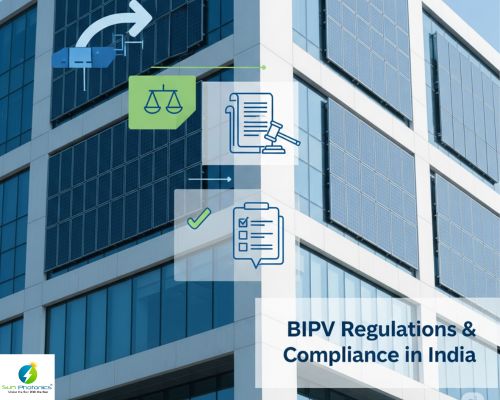Winters expose every weakness in a rooftop solar system — moisture, fog, temperature swings, metal
Read MoreIntroduction: Why BIPV Is Gaining Traction in India (2026 Update)
Cities are growing taller, streets are getting denser, and every square foot of real estate feels like it’s worth its weight in gold.
Rooftop space? Well, let’s just say it’s often already taken water tanks, HVAC units, or other rooftop systems, leaving little room for any other things to accommodate, like traditional solar panels
We always talk about Building-Integrated Photovoltaics (BIPV). Think of it not as panels you bolt onto a roof, but as solar technology woven into the building’s at its façades, windows, skylights, and cladding For businesses exploring BIPV cost in India for commercial buildings, this isn’t just about adding solar; it’s about merging design with performance.
It’s like your office or factory quietly doubles as a solar plant without screaming “I’ve got panels on me!”. Aesthetics and energy in one neat package — and when you factor in BIPV Cost in India for Commercial Buildings, it’s clear why businesses see this as a smart long-term play


Design and Sustainability: But what’s really pushing BIPV into the spotlight? Beyond the obvious energy savings, architects and developers are drawn to the design flexibility. Transparent BIPV panels for office buildings – Now you can get panels that are transparent, tinted, or patterned, so instead of clunky black rectangles, you get sleek surfaces that reduce heat gain, allow natural light, and score extra points in IGBC and other green building certifications.
Investment Expenditure: Of course, we’ve got to be honest—BIPV systems isn’t all sunshine and rainbows. The initial investment is higher than conventional rooftop systems, partly because it requires integration during construction or major renovation. Add to that design coordination challenges between architects and engineers, plus limited market awareness, and you see why adoption has been slower than it could be.
Yet, the potential is enormous. Studies estimate India could harness over 300 GW of solar power from existing building integrated solar systems alone. Imagine tapping even a fraction of that, it could offset massive chunks of our urban energy demand.
What’s missing?
Clear policy incentives, Awareness and mandatory inclusion in building codes are must require to follow.
Momentum, however, is clearly building. The technology is evolving, costs are gradually falling, and early adopters—especially in the commercial and industrial segments—are starting to showcase successful projects.
| Feature | BIPV Panels (Building-Integrated PV) | Rooftop Solar (BAPV – Applied PV) |
|---|---|---|
| Aesthetics | Seamless, customizable façade/window | Panels mounted visibly on roof |
| Space Utilization | Vertical or sloped façades | Uses roof only, limited if rooftop small |
| Cost (Upfront) | Higher—complex design and materials | Lower—standard panels and mounts |
| Energy Efficiency | Adds insulation, reduces heat gain | Generates electricity only |
| Financial Incentives | Limited yet to be formalized | Accelerated depreciation, GST, net-metering |
| ROI / Payback | 5–7 years typical with savings | 3–5 years common for commercial rooftops |
| Design Integration | Requires coordination with architects | Retrofit-friendly |
| Green Building Ratings | Enhances façade sustainability | Improves energy metrics only |
BIPV can be more expensive and design-intensive, but it integrates energy functions with design, and can raise the cool factor of a building. Rooftop solar remains cheaper and simpler, especially with benefits like 40% accelerated depreciation and net-metering across the states. But for architects and designers, BIPV offers that WOW factor you can’t ignore.
India does not yet have a fully dedicated, nationwide subsidy program for Building‑Integrated Photovoltaics (BIPV) systems, particularly for commercial projects. While rooftop solar enjoys well-defined policies, BIPV is still in a regulatory grey area. That said, recent MNRE guidelines under the PM Surya Ghar: Muft Bijli Yojana allow BIPV and balcony solar in certain cases, making them eligible for subsidies, though primarily for residential or limited-scale projects.
Policy discussions are ongoing in think-tank and government circles to formally include BIPV in existing solar incentive schemes. If adopted, building codes and green certification frameworks like GRIHA or IGBC could make BIPV not just attractive but a practical option for new commercial buildings. This could also help address current cost concerns for BIPV in India, gradually improving financial viability and encouraging broader adoption.
What We Already Have (For Rooftop Solar, Not Yet for BIPV)
The gap: None of these are yet directly tailored for BIPV. Without explicit coverage, many developers treat BIPV purely as a premium architectural feature, not a subsidised energy investment.


Commercial rooftop solar in India generally costs around ₹4.5–6 crore per MW. That’s not small change, but annual energy savings can hit ₹1.5–2 crore per MW, giving a payback period of 3–5 years in most commercial use cases.
BIPV? Expect it to cost more upfront – sometimes 15–30% higher—because you’re not just buying solar modules; you’re paying for custom integration into windows, façades, or cladding. But here’s the twist: since BIPV modules replace conventional building materials (glass panels, façade tiles, shading devices), part of that cost offsets what you would have spent on construction anyway. Plus, integrated panels improve thermal insulation, lowering HVAC loads—a hidden ROI booster often ignored in basic payback calculations.
State-Level Notes
Some Indian states are more progressive in solar policy:
Bottom line: As of now, BIPV buyers in India mostly rely on custom financing models, green loans, or CSR-linked investments to make projects viable. But with policy inclusion, we could see paybacks approach rooftop solar levels—while delivering superior aesthetics and green building credentials.
Building-Integrated Photovoltaics (BIPV) aren’t just solar panels put on the wall—they’re part of the building, serving both as a renewable energy source and as a construction material.
Here’s how to get it right from start to finish.
Step 1: Feasibility Study & Site Audit
Before jumping into design, a proper technical audit is crucial.
Step 2: Design & Integration Planning
This is where the architects and solar engineers work hand in hand.
Step 3: Regulatory & Compliance Approvals
BIPV must meet both building and solar energy regulations.
Step 4: Financing & Incentives
BIPV is an upfront investment, but several funding routes can ease the cost:
Step 5: Procurement & Vendor Selection
Not all panels are created equal—quality matters.
Step 6: Building Integrated Photovoltaics installation in India
This stage requires precise coordination between the civil, façade, and electrical teams.
Step 7: Monitoring & Maintenance
BIPV is low-maintenance but still needs care.
Currently, India doesn’t have a dedicated set of subsidies, policy, incentives, or building codes designed exclusively for Building Integrated Photovoltaics (BIPV) systems. That means if you’re an architect, builder, or corporate decision-maker, you’re working in a bit of a regulatory grey zone.


1 – IGBC Green Ratings – Your Current Gateway
The Indian Green Building Council (IGBC)’s Green New Buildings rating system already encourages architects to embed renewable energy solutions into their designs. While it doesn’t list BIPV as a separate category yet, integrating these systems can help you score points in multiple areas:
The IGBC system is flexible enough to reward such integrations across all climates and building types in India.
2 – Policy Gaps and What’s Coming
Think-tanks like BUILD UP and various energy policy researchers have recommended:
This would mean future codes could require or incentivize BIPV for certain building categories—especially commercial and public infrastructure. (Source: BUILD UP)
3 – Using Existing Incentives
While there’s no BIPV-exclusive subsidy yet, some existing PV-friendly policies may apply:
4 – The Action You Have to Take
If you’re in the architecture or commercial & industrial (C&I) space, now’s the time to speak up. Policy shifts often come from industry push, whether that’s lobbying for a BIPV inclusion clause in the Energy Conservation Building Code (ECBC) or proposing pilot projects in government buildings.
Your next project could become the benchmark for India’s first generation of BIPV-compliant structures. And when that happens, you won’t just be ticking a sustainability box—you’ll be shaping the market.
If you’re still reading, you’re not just curious, you’re committed to exploring real solutions.
Here’s your next step: We are offering a no-cost BIPV feasibility and ROI assessment tailored specifically for commercial and industrial projects.
We’ll analyze your building’s location, state-specific energy tariffs, and architectural layout to determine the best BIPV integration strategy. You’ll get:
All you need to do is Send US Your Project Details—site location, size, and energy requirements, and our Project Advisory Service team get started analyzing. Let’s transform your building into a long-term clean energy asset that works as hard as you do.
Jatin Singh is a content developer at Sun Photonics Pvt. Ltd., specializing in creating impactful content for solar energy solutions. With a background in tech and health, he has previously worked in digital marketing and pharma. Passionate about sustainability, and currently exploring all things about solar!
Approval by an Expert:
“This content is reviewed and approved by Dr. Sujata Bhaker, who holds a Doctorate in Renewable Energy and brings over 10 years of industry expertise.”
BIPV (Building-Integrated Photovoltaics) are solar panels built into the structure of a building—like façades, windows, or skylights—whereas rooftop solar (BAPV) involves mounting panels on top of an existing roof. BIPV combines design with energy generation, while rooftop solar focuses mainly on power generation.
With cities getting denser and rooftop space becoming limited, businesses and architects are turning to BIPV for its dual benefits—clean energy generation and modern aesthetics. The growing push for green building certifications like IGBC also adds to its popularity.
BIPV is typically 15–30% more expensive than conventional rooftop solar due to design integration and customized materials. However, part of the cost is offset because BIPV replaces conventional building materials like glass and cladding.
The payback period for BIPV is generally 5–7 years, compared to 3–5 years for rooftop solar. However, BIPV delivers additional hidden savings through improved insulation, reduced HVAC loads, and enhanced building value.
Currently, India does not have a dedicated subsidy program for BIPV. However, businesses may still benefit indirectly from existing solar incentives such as accelerated depreciation, IREDA loans, GST concessions, and carbon credit schemes.
BIPV saves space by utilizing façades, improves aesthetics, adds insulation, and helps achieve higher green building ratings. Rooftop solar, on the other hand, is cheaper and easier to install but requires roof availability.
The main barriers include higher upfront costs, lack of clear policy incentives, limited awareness, and the need for close coordination between architects and engineers during design and construction.
The process involves seven steps: feasibility study, design integration, regulatory approvals, financing, procurement of panels, installation, and ongoing monitoring & maintenance. It requires coordination between civil, façade, and electrical teams.
States like Haryana and Gujarat already have progressive rooftop solar policies, including mandatory installations and duty waivers. If similar frameworks extend to BIPV, adoption in commercial hubs could accelerate quickly.
Commercial building owners, architects, real estate developers, and businesses seeking long-term sustainability and green certification benefits should consider BIPV. It is especially suited for dense urban areas with limited rooftop space.
Winters expose every weakness in a rooftop solar system — moisture, fog, temperature swings, metal
Read MoreAs India accelerates its path toward clean and sustainable green energy, the role of Solar
Read MoreIndia’s energy sector is transforming rapidly, and commercial rooftop solar has emerged as a core
Read MoreChoosing the Best Solar System for Industries is not just about going green — it’s
Read MoreRead our quick GEOA guide already? Cool. But this one’s built for people who need
Read More